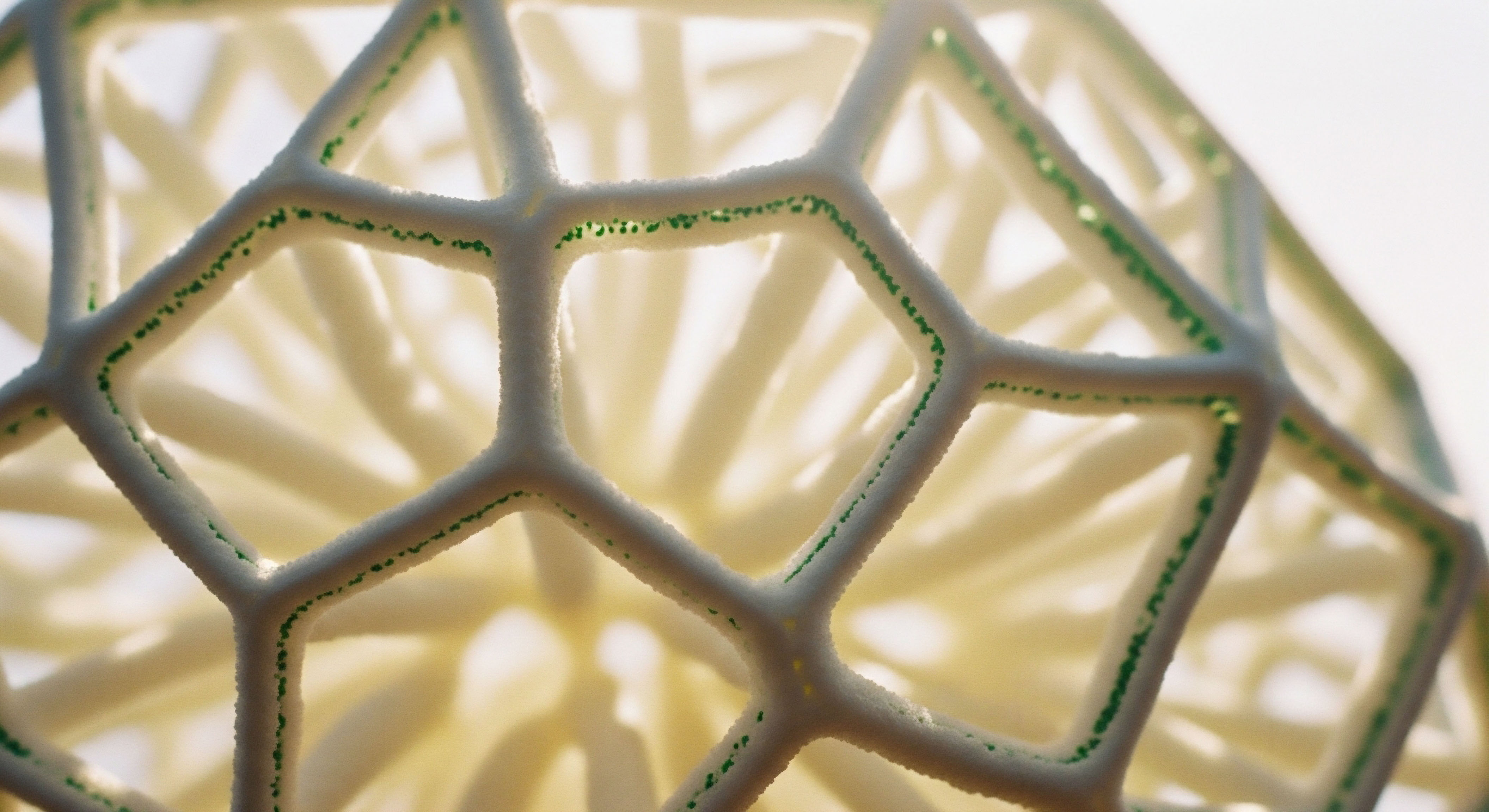

Fundamentals
The experience of a muscle injury is profoundly personal. It is a sudden, sharp interruption to your life’s rhythm, a frustrating separation between your intention and your body’s capacity. The feeling of vulnerability that follows, the daily calculation of what you can and cannot do, is a heavy burden.
This journey back to wholeness begins with understanding the elegant biological processes that govern healing. Your body possesses an innate, powerful drive to repair itself. When muscle fibers are torn, a sophisticated and highly coordinated cascade of events is initiated. This is a conversation happening at the cellular level, and the language it uses is biochemical.
Imagine your endocrine system as the body’s internal communication network. It uses hormones as messengers, sending precise instructions throughout your system to manage everything from your energy levels to your response to stress. In the context of muscle repair, certain hormonal signals are absolutely vital.
The pituitary gland, a small structure at the base of your brain, releases Growth Hormone (GH). GH is a primary conductor of the healing orchestra, signaling tissues to rebuild and regenerate. This hormone, in turn, prompts the liver to produce Insulin-Like Growth Factor 1 (IGF-1), another critical messenger that travels to the site of injury and directly stimulates the proliferation of muscle stem cells, known as satellite cells.
These cells are the architects of repair; they fuse to damaged muscle fibers, donating their nuclei and building new, stronger tissue. The entire process is a testament to the body’s resilience.
Peptides enter this conversation as highly specific, targeted messages. They are short chains of amino acids, the fundamental building blocks of proteins. You can think of them as specialized keys designed to fit specific locks on the surface of your cells. When a peptide binds to its receptor, it delivers a precise instruction.
Some peptides are designed to mimic the body’s own signaling molecules, amplifying the natural healing response. For instance, certain peptides can signal the pituitary gland to increase its output of Growth Hormone, thereby enhancing the entire downstream cascade of repair.
Others have more direct actions, working locally at the site of injury to improve blood flow or manage the inflammatory response. This targeted signaling is what makes peptide therapy such a focused tool. It works with your body’s existing systems, aiming to optimize the intricate biological dialogue that underpins your recovery and return to full function.


Intermediate
To appreciate how peptides facilitate muscle repair, we must look closer at the specific protocols and the mechanisms they employ. These are not blunt instruments; they are sophisticated tools designed to interact with the body’s regulatory feedback loops. We can categorize these peptides based on their primary mechanism of action, creating a clearer picture of how a personalized wellness protocol is constructed. The two main categories relevant to muscle recovery are Growth Hormone Secretagogues (GHS) and specialized tissue-healing peptides.

Growth Hormone Secretagogues the Conductors of Anabolism
Growth Hormone Secretagogues are peptides that stimulate the pituitary gland to release your body’s own growth hormone. This approach preserves the natural, pulsatile release of GH, which is crucial for its safe and effective action. This is a key distinction from administering synthetic HGH directly. Different peptides in this class work on different pathways, and they are often combined to create a synergistic effect.

Sermorelin
Sermorelin is a synthetic version of the first 29 amino acids of Growth Hormone-Releasing Hormone (GHRH). GHRH is the natural signal your hypothalamus sends to your pituitary gland to produce and release GH. Sermorelin functions by mimicking this signal, effectively knocking on the door of the pituitary and encouraging it to perform its natural function. By boosting GH levels, Sermorelin supports increased protein synthesis and cellular repair, which are foundational for muscle recovery.

Ipamorelin and CJC-1295 a Synergistic Combination
This combination represents a more advanced strategy for GH optimization. These two peptides work on different receptors to amplify the GH pulse significantly.
- CJC-1295 is a long-acting analog of GHRH. Its structure allows it to remain active in the body for a longer period, providing a sustained signal to the pituitary to produce GH.
- Ipamorelin is a ghrelin mimetic. Ghrelin is often known as the “hunger hormone,” but it also has a powerful effect on GH release through a separate receptor pathway (the GHSR receptor). Ipamorelin is highly selective, meaning it stimulates GH release with very little to no effect on other hormones like cortisol or prolactin.
When used together, CJC-1295 provides a steady, elevated baseline of GHRH signaling, while Ipamorelin provides a strong, clean pulse for GH release. The result is a robust and physiological surge of natural growth hormone, timed to optimize recovery, particularly when administered before sleep, which is when the body’s natural GH pulses are at their peak. This dual-action approach enhances lean muscle development, accelerates repair processes, and improves sleep quality, all of which are interconnected elements of a successful recovery.
Peptides that stimulate growth hormone work by amplifying the body’s own natural signals for repair and regeneration.

What Are the Primary Tissue Repair Peptides?
While GHS peptides create a systemic anabolic environment conducive to healing, other peptides offer direct, localized support to injured tissues. They work at the ground level, orchestrating the cellular mechanics of repair.

BPC-157 the Systemic Healing Agent
Body Protection Compound 157 (BPC-157) is a synthetic peptide derived from a protein found in the stomach. Its primary role appears to be protective and reparative. Its influence on muscle and connective tissue repair is multifaceted and profound. Animal studies suggest BPC-157 accelerates healing through several distinct mechanisms:
- Angiogenesis It promotes the formation of new blood vessels. An enhanced blood supply to an injured area is critical for delivering oxygen, nutrients, and the cellular building blocks necessary for repair, while also clearing away metabolic waste.
- Fibroblast Activation It stimulates the activity of fibroblasts, the cells responsible for producing collagen and other components of the extracellular matrix that form the scaffold for new tissue.
- Growth Hormone Receptor Upregulation Research indicates that BPC-157 can increase the sensitivity of tissues to growth hormone by upregulating GH receptors on cells like tendon fibroblasts. This makes the systemic GH released by secretagogues even more effective at the site of injury.
- Modulation of Inflammation It appears to regulate the inflammatory response, preventing the excessive or chronic inflammation that can impede healing.
BPC-157 is often used to address specific injuries like muscle tears, tendonitis, and ligament sprains, supporting a more organized and structurally sound healing process.
The following table provides a comparative overview of these key peptides.
| Peptide | Primary Mechanism | Key Benefits for Muscle Repair | Typical Administration Route |
|---|---|---|---|
| Sermorelin | GHRH Analog | Increases natural GH production, improves sleep, supports lean mass. | Subcutaneous Injection |
| CJC-1295 / Ipamorelin | GHRH Analog + Ghrelin Mimetic | Synergistic, strong pulse of natural GH, enhances recovery and fat loss. | Subcutaneous Injection |
| BPC-157 | Direct Tissue Repair / Angiogenesis | Accelerates healing of muscle/tendon, increases blood flow, reduces inflammation. | Subcutaneous or Oral |


Academic
A sophisticated understanding of peptide therapy for muscle repair requires a systems-biology perspective. The body does not operate in silos. The recovery of musculoskeletal tissue is deeply intertwined with the state of the entire endocrine system, particularly the dynamic interplay between anabolic and catabolic signaling pathways.
Peptides function as targeted modulators within this complex system, capable of shifting the net balance toward anabolism and regeneration. To fully grasp their influence, we must examine their effects on the Hypothalamic-Pituitary-Gonadal (HPG) and Hypothalamic-Pituitary-Adrenal (HPA) axes, as well as their direct molecular actions at the cellular level.

How Do Peptides Interact with the Neuroendocrine Axis?
The state of the neuroendocrine system dictates the body’s capacity for repair. High physiological or psychological stress activates the HPA axis, leading to the release of cortisol. Chronically elevated cortisol is catabolic; it promotes the breakdown of muscle protein (proteolysis) to supply amino acids for glucose production (gluconeogenesis).
This creates an endocrine environment that is hostile to recovery. Conversely, anabolic hormones like testosterone (governed by the HPG axis) and Growth Hormone (governed by the GHRH/Ghrelin axis) promote protein synthesis and tissue building.
Growth Hormone Secretagogues (GHS) like Sermorelin, CJC-1295, and Ipamorelin directly and favorably influence this balance. By stimulating the pituitary to release a robust, physiological pulse of GH, they initiate a cascade of anabolic signaling. GH itself has direct effects, but its primary anabolic influence is mediated by Insulin-Like Growth Factor 1 (IGF-1).
IGF-1, produced mainly in the liver in response to GH, is a potent activator of the mTOR pathway, a central regulator of cell growth and protein synthesis in muscle cells. Simultaneously, a healthy GH pulse is associated with deeper, more restorative sleep, which can help downregulate HPA axis activity and lower cortisol levels, further tilting the balance toward anabolism.

What Is the Molecular Mechanism of BPC-157?
The regenerative capacity of BPC-157 is best understood by examining its molecular footprint. While its full range of interactions is still being elucidated, research points to several key pathways that explain its efficacy in healing musculoskeletal injuries.
- VEGF Pathway and Angiogenesis ∞ BPC-157 has been shown to dose-dependently increase the expression of Vascular Endothelial Growth Factor (VEGF) receptors. VEGF is the master regulator of angiogenesis. By sensitizing the local tissue to VEGF, BPC-157 accelerates the formation of new capillaries (angiogenesis) into the injured area. This neovascularization is a rate-limiting step in healing, as it provides the conduits for nutrient delivery and waste removal.
- Nitric Oxide (NO) System Modulation ∞ The peptide appears to interact with the nitric oxide system. NO is a critical signaling molecule involved in vasodilation (improving blood flow) and the modulation of inflammation. The pro-healing effects of BPC-157 may be mediated in part by its ability to maintain NO homeostasis, protecting against the damaging effects of oxidative stress while harnessing NO’s beneficial effects on blood flow and cellular signaling.
- FAK-Paxillin Pathway and Fibroblast Migration ∞ Studies have demonstrated that BPC-157 promotes the activation of the Focal Adhesion Kinase (FAK)-Paxillin pathway in fibroblasts. This pathway is essential for cell migration. The enhanced migration and spreading of fibroblasts, the cells that synthesize collagen, leads to faster wound closure and more organized deposition of new connective tissue, resulting in a stronger, more functional repair.
The efficacy of healing peptides lies in their ability to orchestrate a complex symphony of cellular repair processes, from building new blood vessels to organizing the collagen matrix.
The following table details the specific molecular targets and resulting physiological effects of BPC-157, illustrating its multi-faceted role in tissue regeneration.
| Molecular Target/Pathway | Cellular Effect | Physiological Outcome in Muscle Repair |
|---|---|---|
| VEGF Receptor Upregulation | Increased sensitivity of endothelial cells to VEGF. | Accelerated angiogenesis and neovascularization of injured tissue. |
| Nitric Oxide (NO) System | Modulation of NO synthase activity and bioavailability. | Improved local blood flow and regulation of inflammatory response. |
| FAK-Paxillin Pathway | Activation in fibroblasts, leading to cytoskeletal reorganization. | Enhanced migration of fibroblasts to the injury site for collagen deposition. |
| Growth Hormone Receptor (GHR) | Increased expression of GHR on tendon fibroblasts. | Potentiation of GH/IGF-1 anabolic signaling at the local tissue level. |
In essence, the clinical application of peptides for muscle repair is a form of applied systems biology. It involves using GHS to create a favorable systemic anabolic environment while simultaneously using agents like BPC-157 to provide direct, localized instructions for cellular repair. This dual approach, grounded in an understanding of both endocrine feedback loops and molecular signaling pathways, represents a highly targeted strategy for accelerating the journey from injury back to optimized function.

References
- Sehic, A. et al. “BPC 157 ∞ The Future of Healing?” Journal of Translational Medicine, vol. 21, no. 1, 2023, pp. 1-15.
- Chang, C. H. et al. “Pentadecapeptide BPC 157 Enhances the Growth Hormone Receptor Expression in Tendon Fibroblasts.” Molecules, vol. 26, no. 19, 2021, p. 5897.
- Teichman, P. G. et al. “Injectable Therapeutic Peptides-An Adjunct to Regenerative Medicine and Sports Performance?” Arthroscopy, vol. 41, no. 2, 2025, pp. 150-152.
- Vingren, J. L. et al. “Hormonal Response to Resistance Exercise.” Strength Training, 2nd ed. Human Kinetics, 2016.
- Raun, K. et al. “Ipamorelin, the first selective growth hormone secretagogue.” European Journal of Endocrinology, vol. 139, no. 5, 1998, pp. 552-561.
- Ionescu, M. and L. D. Fratila. “Sermorelin ∞ a growth hormone-releasing hormone analogue for the treatment of growth hormone deficiency.” Expert Opinion on Investigational Drugs, vol. 18, no. 3, 2009, pp. 339-348.
- Pala, R. et al. “Hormones and Muscle Atrophy.” Advances in Clinical Chemistry, vol. 80, 2017, pp. 185-217.
- Cerovecki, T. et al. “Pentadecapeptide BPC 157 (PL 14736) improves ligament healing in the rat.” Journal of Orthopaedic Research, vol. 28, no. 9, 2010, pp. 1155-1161.

Reflection

Your Body’s Innate Intelligence
The information presented here offers a window into the intricate biological machinery that governs your physical well-being. It reveals that healing is an active, intelligent process, a series of precise cellular conversations that can be supported and amplified.
Understanding these mechanisms is the first step in moving from a passive recipient of symptoms to an active participant in your own recovery. Your body is not a collection of separate parts but a single, interconnected system. The fatigue you feel, the slow recovery after a workout, the nagging pain from an old injury ∞ these are all signals from that system.
This knowledge is a tool. It allows you to ask more informed questions and to view your health through a new lens. It shifts the focus from merely managing symptoms to optimizing the underlying systems that dictate your vitality. Your personal health journey is unique, a complex interplay of your genetics, your history, and your goals.
The path forward involves listening to your body’s signals with a new level of understanding and seeking guidance that respects this complexity. The ultimate goal is to restore the body’s innate intelligence, recalibrating the system to function with the vitality you deserve.

Glossary

endocrine system

muscle repair

pituitary gland

growth hormone

peptide therapy

growth hormone secretagogues

hormone secretagogues

sermorelin

cjc-1295

ipamorelin

bpc-157

angiogenesis

fibroblast activation

growth hormone receptor

anabolic signaling

nitric oxide system




